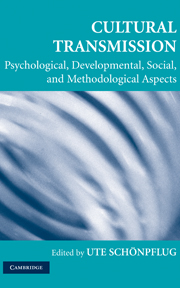Book contents
- Frontmatter
- Contents
- Foreword
- Contributors
- 1 Introduction to Cultural Transmission: Psychological, Developmental, Social, and Methodological Aspects
- 2 Theory and Research in Cultural Transmission: A Short History
- PART ONE EVOLUTIONARY PERSPECTIVE
- 3 Cultural Transmission: A View from Chimpanzees and Human Infants
- 4 Transmission, Self-Organization, and the Emergence of Language: A Dynamic Systems Point of View
- 5 Relationship-Specific Intergenerational Family Ties: An Evolutionary Approach to the Structure of Cultural Transmission
- PART TWO CROSS-CULTURAL PERSPECTIVE
- PART THREE INTRACULTURAL VARIATIONS
- Index
- References
4 - Transmission, Self-Organization, and the Emergence of Language: A Dynamic Systems Point of View
Published online by Cambridge University Press: 05 June 2012
- Frontmatter
- Contents
- Foreword
- Contributors
- 1 Introduction to Cultural Transmission: Psychological, Developmental, Social, and Methodological Aspects
- 2 Theory and Research in Cultural Transmission: A Short History
- PART ONE EVOLUTIONARY PERSPECTIVE
- 3 Cultural Transmission: A View from Chimpanzees and Human Infants
- 4 Transmission, Self-Organization, and the Emergence of Language: A Dynamic Systems Point of View
- 5 Relationship-Specific Intergenerational Family Ties: An Evolutionary Approach to the Structure of Cultural Transmission
- PART TWO CROSS-CULTURAL PERSPECTIVE
- PART THREE INTRACULTURAL VARIATIONS
- Index
- References
Summary
INTRODUCTION
Language is a human capacity that is typically transmitted from one generation to another (one speaks about one's mother tongue, for instance). However, what does transmission mean in this regard? The concept of transmission is well defined in fields like physics or the mathematical theory of information, where it relates to deep principles of the organization of matter, such as entropy. To what extent do we understand transmission if language is concerned? How does it relate to claims about language as an innate capacity? How does intergenerational transmission relate to the emergence or evolution of language over many generations? This chapter discusses these questions from the point of view of dynamic systems theory, which provides a general approach to understanding processes of change and emergence.
A TALE OF HEAT AND ORDER…
Since the early 1990s, developmental psychologists have been exploring a new approach to describing, explaining, and understanding developmental pro-cesses – namely, dynamic systems theory (Thelen & Smith, 1994, 1998; van Geert, 1994, 2003). Dynamic systems theory offers a natural and intuitive approach to such processes. It emphasizes the actual development as it takes place in real time. It explicitly accounts for each step in the process as the direct outcome of the preceding step. It focuses on mutual interactions between variables – that is, forces or components that affect one another. A major feature of dynamic systems thinking is its emphasis on the ubiquitousness of self-organization (Lewis & Granic, 1999).
- Type
- Chapter
- Information
- Cultural TransmissionPsychological, Developmental, Social, and Methodological Aspects, pp. 48 - 69Publisher: Cambridge University PressPrint publication year: 2008
References
- 1
- Cited by

